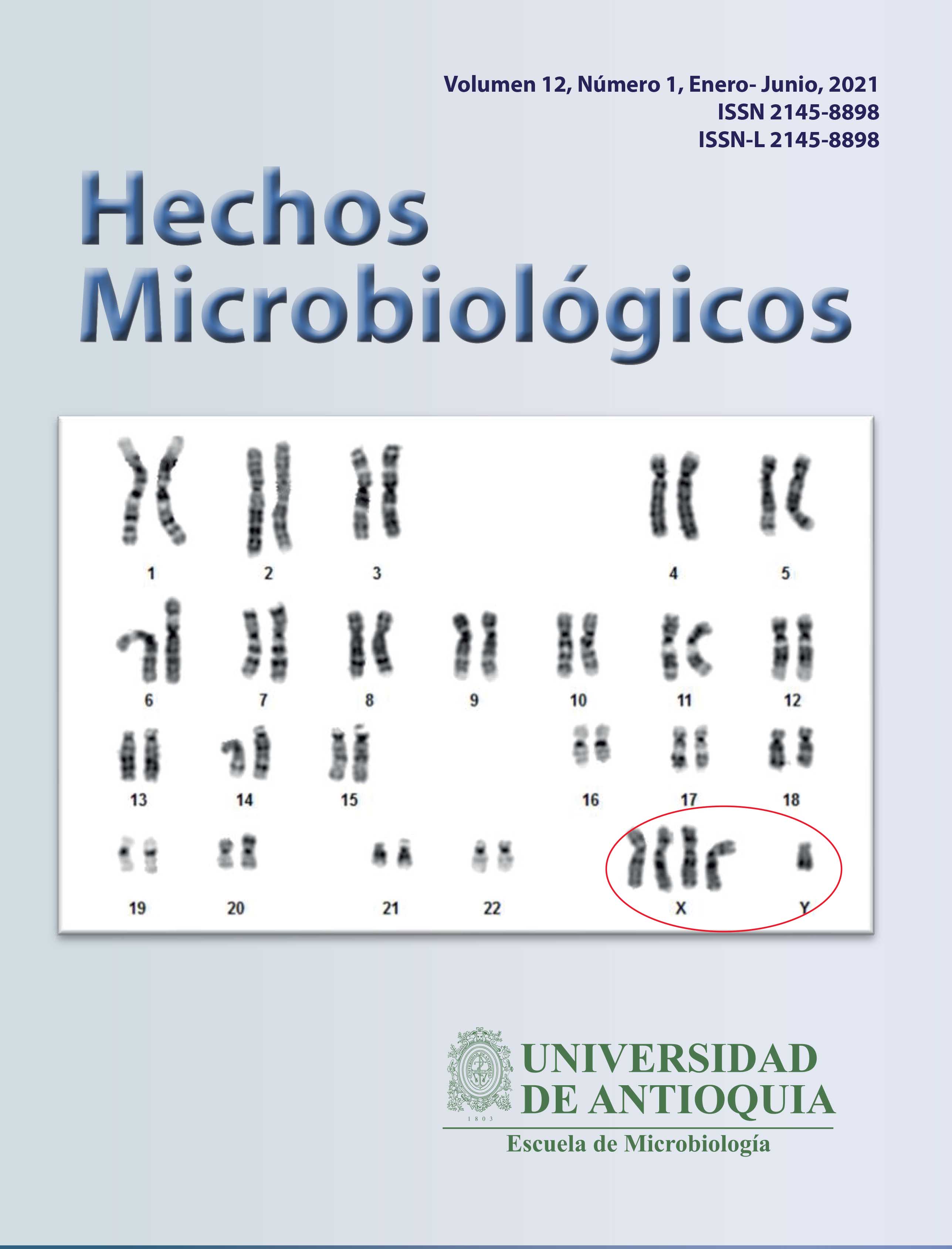Variante cromosómica en síndrome Klinefelter, 49, XXXXY: reporte de un caso en un paciente colombiano
DOI:
https://doi.org/10.17533/10.17533/udea.hm.v12n1a06Palavras-chave:
aneuploidía cromosómica, cariotipo, cromosomas sexuales, fenotipo, Síndrome de Klinefelter, 49,XXXXYResumo
El síndrome Klinefelter (47,XXY) es la aneuploidía cromosómica sexual más frecuente en los hombres (1:650 varones nacidos vivos), el fenotipo clásico es talla alta, infertilidad, ginecomastia, testículos y pene pequeños. El síndrome 49,XXXXY es la variante cromosómica menos común del síndrome de Klinefelter con una presentación clínica más severa. En el presente artículo describimos el primer caso de un paciente colombiano con síndrome 49,XXXXY, quien presenta rasgos dismórficos llamativos, alteraciones musculo esqueléticas y retardo global del desarrollo y del lenguaje.
Downloads
Referências
Bearelly P, Oates R. Recent advances in managing and understanding Klinefelter syndrome. F1000Research. 2019;8(0):112.
Kanakis GA, Nieschlag E. Klinefelter syndrome: more than hypogonadism. Metabolism. 2018;86:135–44.
Dhakar MB, Ilyas M, Jeong JW, Behen ME, Chugani HT. Frontal Aslant Tract Abnormality on Diffusion Tensor Imaging in an Aphasic Patient with 49, XXXXY Syndrome. Pediatr Neurol. 2016;55:64–7.
Mazzilli R, Delfino M, Elia J, Benedetti F, Alesi L, Chessa L, et al. Testosterone replacement in 49,XXXXY syndrome: andrological, metabolic and neurological aspects. Endocrinol Diabetes Metab Case Reports. 2016;(January):8–11.
Etemadi K, Basir B, Ghahremani S. Neonatal diagnosis of 49,XXXXY syndrome. Iran J Reprod Med. 2015;13(3):181–4.
Putra M, Hicks M, Abramowicz J. False Low-Risk Single Nucleotide Polymorphism–Based Noninvasive Prenatal Screening in Pentasomy 49, XXXXY. Am J Perinatol Reports. 2018;8(1):e4–6.
Burgemeister AL, Daumiller E, Graul-neumann LM, Köhler B, Knecht S, Burgemeister S, et al. Clinical report of 8 patients with 49,XXXXY syndrome : Delineation of the facial gestalt and depiction of the clinical spectrum. Eur J Med Genet. 2019;62(3):210–6.
Smyth, CM, Bremner WJ. Klinefelter syndrome. Archives of Internal Medicine, 1998;158(12):1309-1314.
Kidszun A, Fuchs A, Russo A, Bartsch M, Frey-mahn G, Beyer V, et al. Skeletal abnormalities of the upper limbs — Neonatal diagnosis of 49,XXXXY syndrome. Gene. 2012;508(1):117–20.
Milani D, Bonarrigo F, Avignone S, Triulzi F, Esposito S. 48, XXXY / 49,XXXXY mosaic: new neuroradiological features in an ultra-rare syndrome. Ital J Pediatr. 2015;1–4.
del Río RG, dos Santos TJ, Travieso-Suárez L, Muñoz Calvo MT, Argente J. Karyotype 48,XXXY/49,XXXXY and proximal radioulnar synostosis. An Pediatría. 2018;88(5):282–4.
Sumathipala D, Gamage T, Wijesiriwardena B, Jayasekara RW, Dissanayake VHW. An Infant Born to a Mother with Gestational Diabetes Presenting with 49,XXXXY Syndrome and Renal Agenesis-A Case Report. J Clin Res İn Pediatr Endocrinol. 2012;4(4):223–5.
Lu YC, Huang LY, Yang YD, Li DZ. Early prenatal diagnosis of 49,XXXXY: two case reports. J Obstet Gynaecol (Lahore). 2019;39(2):275–7.
Tosi L, Mitchell F, Porter GF, Ruland L, Gropman A, Lasutschinkow PC, et al. Musculoskeletal abnormalities in a large international cohort of boys with 49, XXXXY. Am J Med Genet. 2020;(March):1–10.
Visootsak J, Rosner B, Dykens E, Tartaglia N, Jr JMG. Behavioral henotype of Sex Chromosome Aneuploidies : Am J Med Genet. 2007;1203:1198–203.
Blumenthal JD, Baker EH, Raitano N, Wade B, Clasen LS, Lenroot RK, et al. Brain morphological abnormalities in 49,XXXXY syndrome : A pediatric magnetic resonance imaging study. Neurolmage:Clinical. 2013;2:197–203.
Frühmesser AKD. Chromosomal Variants in Klinefelter Syndrome. Sex Dev. 2011;109–23.
Keller MD, Sadeghin T, Samango-sprouse C, Orange JS. Immunodeficiency in Patients With 49,XXXXY Chromosomal Variation. Am J Med Genet. 2016;163(1):50- 54.
Perez EE, Ballow M. Diagnosis and management of Specific Antibody Deficiency. Immunol Allergy Clin North Am. 2020;40(3):499–510.
Sorensen RU, Edgar D. Specific Antibody Deficiencies in Clinical Practice. J Allergy Clin Immunol Pract. 2019;7(3):801–8.
Gropman AL, Rogol A, Fennoy I, Sadeghin T, Sinn S, Jameson R, et al. Clinical Variability and Novel Neurodevelopmental Findings in 49,XXXXY Syndrome. Am J Med Genet Part A. 2010; 152(6):1523-1530.
Wei L, Liu Y, Sun S, Tang Y, Chen S, Song G. Case report of 49,XXXXY syndrome with cleft palate, diabetes, hypothyroidism, and cataracts. Medicine (Baltimore). 2019;39(July):2–4.
Maqdasy S, Bogenmann L, Batisse-Lignier M, Roche B, Franck F, Desbiez F, et al. Leydig cell tumor in a patient with 49,XXXXY karyotype: A review of literature. Reprod Biol Endocrinol. 2015;13(1):1–9. 63 Hechos Microbiol. 2021;112(1):56-63
Tartaglia N., Ayari N., Howell S., Epagnier C. ZP. 48, XXYY, 48, XXXY and 49,XXXXY syndromes : not just variants of Klinefelter syndrome. Acta Pædiatrica. 2011;851–60.
Cumming A, Manzanilla-García HA, Venegas-Vega C, Arana-Trejo RM, Aizpuru E. Partial orchiectomy in a case of Leydig cell tumor associated with Klinefelter syndrome. Rev Mex Urol. 2017;77(4):296–301.
Samango-Sprouse CA, Gropman AL, Sadeghin T, Kingery M, Lutz- Armstrong M, Rogol AD. Effects of short-course androgen therapy on the neurodevelopmental profile of infants and children with 49,XXXXY syndrome. Acta Paediatr Int J Paediatr. 2011;100(6):861–5.
Samango-Sprouse CA, Sadeghin T, Mitchell FL, Dixon T, Stapleton E, Kingery M, et al. Positive effects of short course androgen therapy on the neurodevelopmental outcome in boys with 47, XXY syndrome at 36 and 72 months of age. Am J Med Genet Part A. 2013;161(3):501–8.
Samango-Sprouse C, Stapleton EJ, Lawson P, Mitchell F, Sadeghin T, Powell S, et al. Positive effects of early androgen therapy on the behavioral phenotype of boys with 47, XXY. Am J Med Genet Part C Semin Med Genet. 2015;169(2):150–7.
Bonilla FA, Bernstein IL, Khan DA, Ballas ZK, Chinen J, Frank MM, et al. Practice parameter for the diagnosis and management of primary immunodeficiency. Ann Allergy, Asthma Immunol. 2005;94(5 SUPPL. 1):S1– 63.
Orange JS, Ballow M, Stiehm ER, Ballas ZK, Chinen J, De La Morena M, et al. Use and interpretation of diagnostic vaccination in primary immunodeficiency: A working group report of the Basic and Clinical Immunology Interest Section of the American Academy of Allergy, Asthma & Immunology. J Allergy Clin Immunol. 2012;130(3 Suppl):S1–24.








